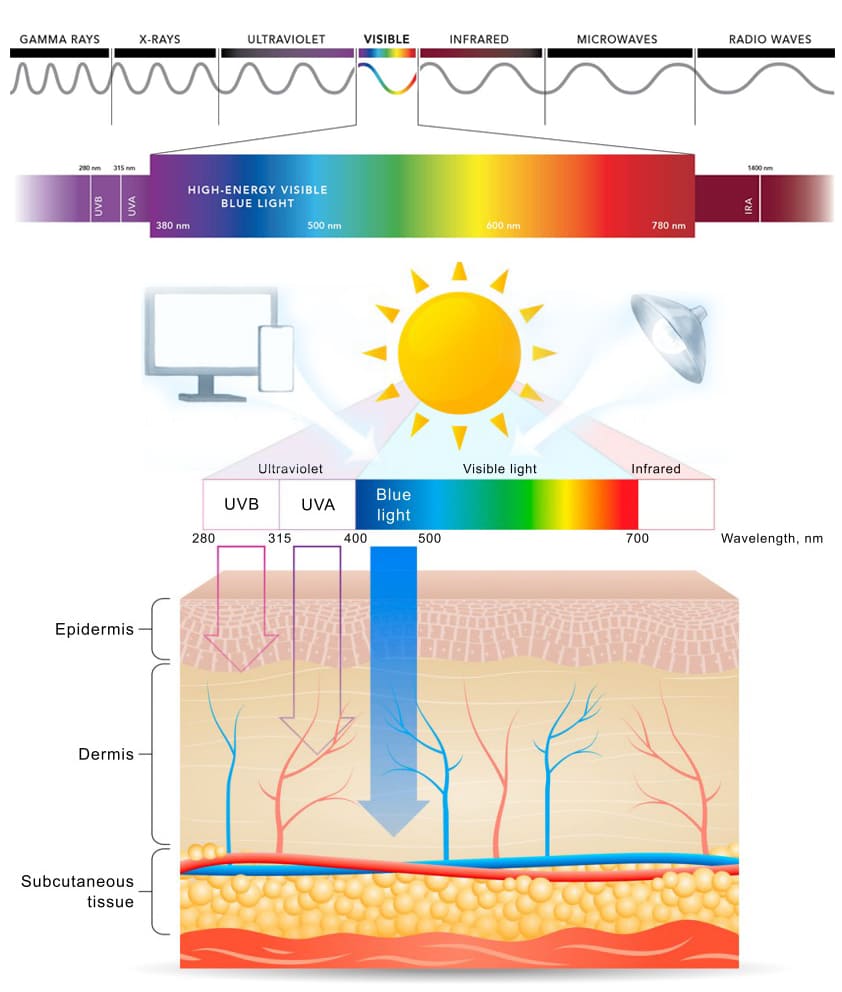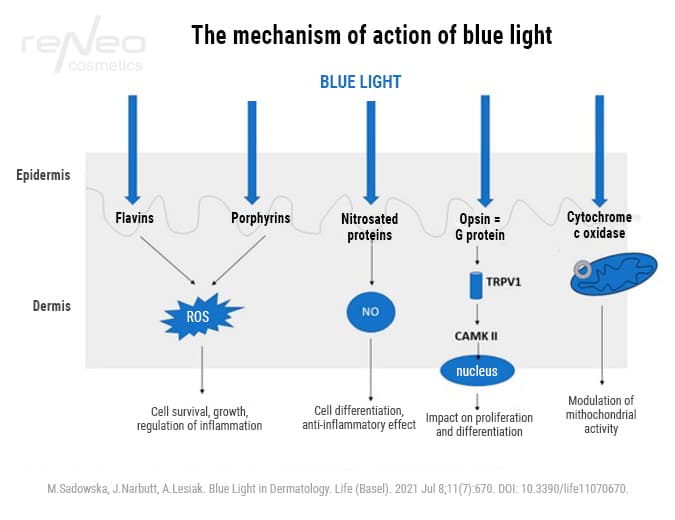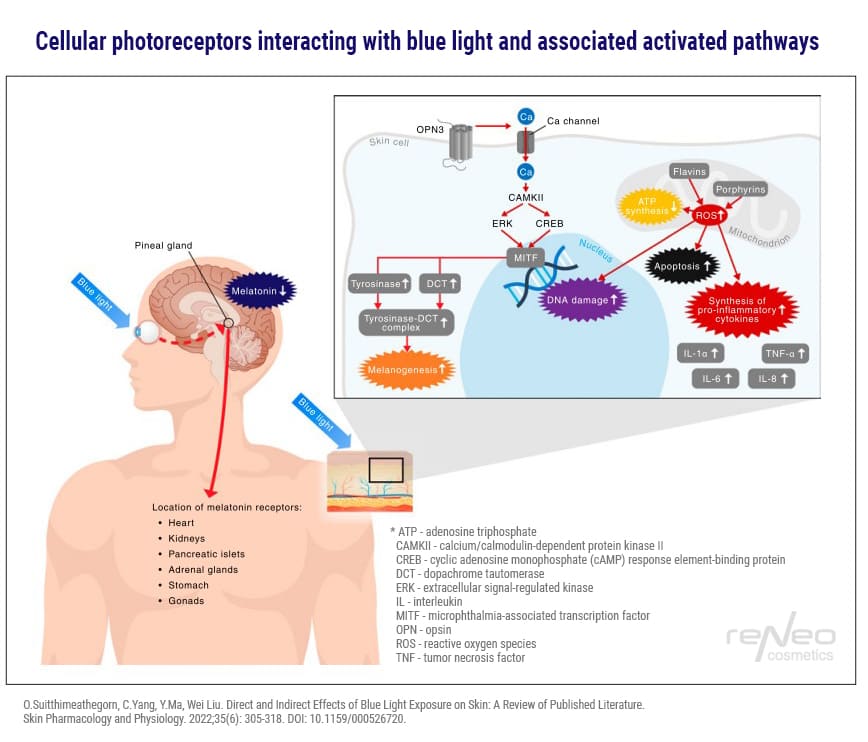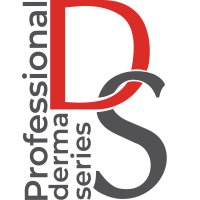According to statistics, people check their phones 58 times a day. On average, a modern person spends 4 hours and 37 minutes with a smartphone. This is approximately 70 days per year. So we spend a fifth of our time looking at mobile phone screens. And this is without taking into account computer work and the use of other digital devices. These screens emit so-called blue light.
What is blue light?
Blue light is part of the visible spectrum and refers to HEV radiation (High Energy Visible Light). The wavelength is 380-500 nanometers (nm). Its source is primarily the sun. In addition, carriers of blue light are LED lamps, flashlights, screens of smartphones, computers, TVs, xenon and energy-saving lamps and any other artificial sources. That is, blue light is almost all the light we see. Even the sky is blue precisely because blue light makes it so. HEV radiation is an important part of human life. Blue light is necessary to regulate the circadian rhythm because it stimulates melanopsin (light-sensitive protein) receptors in the eyes. This suppresses daytime melatonin, which ensures wakefulness during the day and sleep at night when the melatonin hormone levels are higher. Melatonin is responsible for the quality of sleep, functioning of all body processes and appearance. Blue light, which we receive together with solar radiation, is necessary for normal growth, vision, well-being and mood. Deficiency can lead to depression, apathy, etc. Blue light has anti-proliferative properties and is used for therapeutic purposes in skin diseases, including psoriasis. However, modern research has also revealed its potentially harmful effects. Studies of the effects and potential harm of blue light began relatively recently, already in the 21st century, and were initially related to the effects of radiation on the retina of the eye. The possible damage to the skin was discussed later, when scientists discovered that blue light, like UVA/UVB rays, can create reactive oxygen species in the body.
What is the difference between blue light and UVA and UVB rays?
The main difference is the wavelength. UV radiation is invisible to the human eye and is divided into three types: UVA (315-400 nm), UVB (280-315 nm) and UVC (100-280 nm). UVC does not reach the Earth’s surface because it is completely absorbed by the atmosphere. UVB interacts with the cells of the epidermis, that is, it causes sunburn and it damages the upper layers of the skin. UVA penetrates deeper into the skin, affects the immune cells of the epidermis and dermis and causes aging.  Visible light penetrates deeper into the skin than ultraviolet radiation, but it acts more superficially than UV. Hemoglobin and melanin of the epidermis absorb visible light very efficiently. Blue light has a high-energy wavelength in the range from 380 to 500 nm, so it can more easily penetrate deeper layers of the skin – to a depth of 0.07-1 mm.
Visible light penetrates deeper into the skin than ultraviolet radiation, but it acts more superficially than UV. Hemoglobin and melanin of the epidermis absorb visible light very efficiently. Blue light has a high-energy wavelength in the range from 380 to 500 nm, so it can more easily penetrate deeper layers of the skin – to a depth of 0.07-1 mm.
What effect does blue light have on the skin?
Unlike ultraviolet radiation, the effects of blue light on the body are still being studied. But scientists have already reached several interesting conclusions. Blue light has a direct effect on the skin, interacting with chromophores: flavins, porphyrins, opsins, nitrosated proteins (for example, S-nitroalbumin). Activation of these molecules leads to overproduction of reactive oxygen species (ROS), release of reactive nitrogen species (nitric oxide (NO)), hyperpigmentation.  Oxidative stress. Like UVA rays, HEV radiation generates free radicals (ROS – reactive oxygen species). The primary free radical produced under the influence of blue light is superoxide (O2), a highly reactive radical anion produced by flavins. The formation of superoxide can play a significant role in skin aging. By causing DNA damage, ROS also cause inflammation and destruction of healthy collagen and elastin, which contributes to sagging skin, premature aging, and the appearance of wrinkles. In skin cells, blue light activates the enzyme matrix metalloproteinases (MMPs), which break down existing collagen, accelerate the aging process, and also prevent the synthesis of new collagen, preventing healing.
Oxidative stress. Like UVA rays, HEV radiation generates free radicals (ROS – reactive oxygen species). The primary free radical produced under the influence of blue light is superoxide (O2), a highly reactive radical anion produced by flavins. The formation of superoxide can play a significant role in skin aging. By causing DNA damage, ROS also cause inflammation and destruction of healthy collagen and elastin, which contributes to sagging skin, premature aging, and the appearance of wrinkles. In skin cells, blue light activates the enzyme matrix metalloproteinases (MMPs), which break down existing collagen, accelerate the aging process, and also prevent the synthesis of new collagen, preventing healing.
Liebmann et al. found out that blue light at 453 nm has no negative effect on human skin cells (keratinocytes and endothelial cells) up to fluences of 500 J/cm2. Similarly, Opländer et al showed that blue light is not toxic to human fibroblasts at 453 nm, as well as at 480 nm. However, blue light at 410 and 420 nm caused increased oxidative stress and was also toxic in a dose- and wavelength-dependent manner. Moreover, small doses of blue light (λ = 410, 420, 453 nm) reduced the antioxidant properties of fibroblasts.
Numerous studies have shown that exposure to blue light causes excessive generation of ROS in cultured human keratinocytes and dermal fibroblasts. In addition, blue light reduces the expression of genes that regulate mitochondrial function, such as early growth response protein 1 (EGR1) and Forkhead Box O1 protein (FOXO1) in primary human keratinocytes and melanocytes. It was also found that exposure to radiation in the range from 360 to 470 nm causes the formation of ROS from carbonylated proteins located in the stratum corneum. This suggests that blue light plays a greater role than UV in the formation of such ROS. Excessive blue light-induced ROS production is associated with decreased cell viability and/or cell proliferation, increased proinflammatory response, and impaired collagen metabolism. Dermal fibroblasts exposed to blue light exhibited general metabolic inhibition, decreased ATP synthesis, impaired transforming growth factor-β signaling (TGF-β), decreased procollagen I synthesis, and decreased collagen lattice contractility. Therefore, blue light can harm cells primarily not by suppressing their antioxidant defenses, but by constantly producing a small amount of free radicals that can bypass the body’s normal defense mechanisms and permanently damage DNA. Although blue light therapy can be used to reduce inflammation in bacterial acne, ROS produced by overexposure to blue light cause inflammation, redness, and swelling. Continuous exposure to blue light can weaken the skin’s barrier function, making it less resistant to environmental damage and reducing the skin’s ability to retain moisture. Excessive production of active forms of nitrogen. In the dermis, blue light also causes the release of free nitric oxide, NO. It was found that:
- blue light exposure significantly increased intradermal levels of free NO (detected by in vitro electron paramagnetic resonance spectrometry with human skin samples)
- irradiation of human skin with blue light resulted in a significant release of NO from the irradiated skin area, as well as a significant translocation of NO from the skin surface to the tissues below (detected by CLD in vivo in healthy volunteers)
NO reacts with superoxide to form peroxynitrite, which can cause DNA damage, leading to cell damage, but apoptosis was not observed. In a study by Kim et al., blue light suppressed innate immune responses in human keratinocytes by inducing S-nitrosylation of various proteins. In humans, the photolytic release of NO from nitrosated proteins is thought to be sufficient to cause significant local vasodilation. Hyperpigmentation. Blue light can cause pigmentation and hyperpigmentation of the skin, including age spots and melasma. A study of 20 volunteers with skin phototypes IV–VI showed that compared to UV radiation, blue light causes darker hyperpigmentation that lasts longer. While both UV radiation and blue light cause hyperpigmentation by generating ROS, only blue light causes hyperpigmentation by stimulating opsin. In skin biopsies from healthy volunteers, exposure to blue light for five consecutive days resulted in an increase in perinuclear vacuolization in keratinocytes and an increase in the number of melanin-A-positive cells. Blue light exposure increased melanin production, oxygen saturation, and hemoglobin content in female volunteers. Skin darkening and erythema have also been observed after exposure to blue light. Blue light increases the production of the pro-inflammatory cytokine TNF by activating activator protein 1 (AP-1) and nuclear factor b (NF-B), as shown by research by Yoo et al. This results in redness and swelling, just as when the same person’s skin is exposed to comparable levels of UVA rays. Violation of circadian rhythms. Exposure to light sources that stimulate melanopsin in the retina at night can disrupt the circadian rhythm. Harvard Health Publishing claims that exposure to blue light at night has a very negative effect on sleep. A report by the French Food Safety Agency describes the disruptive effects for biological rhythms and sleep associated with exposure to even very low levels of blue light in the evening or at night, especially through screens. Poor sleep quality can affect both your overall well-being and appearance. In the long term, chronic lack of sleep can lead to loss of skin elasticity, a gray complexion, and the appearance of folds and wrinkles. 
How to protect the skin from HEV radiation?
1. Reduce the time you use gadgets or turn on the “Blue Light Filter” function.
2. Maintain a water balance, sleep well, and eat foods rich in antioxidants.
3. Use cosmetics containing antioxidants, such as vitamin C, vitamin E, niacinamide. This will help neutralize free radicals caused by blue light and protect the skin from damage.
Vitaminized peptide serum Vita Active Peptide Serum prevents dehydration, brightens the skin, evens out its tone, provides smoothing of small wrinkles. The rich vitamin complex helps to increase the synthesis of ceramides and fatty acids to restore the barrier functions of the skin, provides antioxidant protection, strengthens the vascular wall, participates in the synthesis of many structural components of the skin.
Antioxidant Brightening Aplaflor Serum based on a biotechnological plant complex of 7 alpine herbs due to the combination of phytocomplex with hyaluronic acid and lecithin affects all links of photoaging processes. The serum instantly fills wrinkles and keeps the skin moisturized for a long time, which contributes to the restoration of homeostasis in the epidermis and in the intercellular space of the dermis. Contains a record amount of flavonoids and phytosterols, which have a softening and stimulating effect on the skin, promote moisture retention and healing of the epidermis.
4. Since blue light contributes to skin dehydration, it is important to maintain the integrity of the hydrolipidic barrier and ensure a good level of hydration. Lipid Balancing Light Cream restores the lipid mantle of the skin, normalizes the qualitative and quantitative composition of fatty acids on the surface of the epidermis, prevents moisture loss and increases the protective properties of the skin. Niacinamide in the cream acts as an antioxidant, protecting the DNA of cells from ultraviolet damage, and also increases the synthesis of ceramides and free fatty acids in the epidermis. Glycosphingolipids of biotechnological origin fill the walls of cells damaged by oxidative stress or inflammatory processes. Zinc gluconate has a powerful anti-inflammatory effect, has antioxidant properties, supports the barrier function of the skin, turgor and water balance.
5. Do not forget about protection from the sun, because we receive most of the HEV radiation together with sunlight and UVA and UVB rays. reNeo cosmetics sunscreens reliably protect the skin from the aggressive effects of ultraviolet light thanks to an effective combination of broad-spectrum UVA and UVB filters, and active ingredients:
- Sun-Block Emulsion SPF50 (“dry touch”) perfectly eliminates greasy shine. The Matmarine component in a high concentration effectively controls the work of sebaceous glands, narrows pores and provides an excellent matting effect.
- Cream-Protector SPF30 additionally contains Ronacare Ectoin, which stimulates the skin’s own protective, regenerative and moisturizing systems.
All this will help protect the skin from radiation and keep it healthy for many years.
- O.Suitthimeathegorn, C.Yang, Y.Ma, Wei Liu. Direct and Indirect Effects of Blue Light Exposure on Skin: A Review of Published Literature. Skin Pharmacology and Physiology. 2022;35(6): 305-318. DOI: 10.1159/000526720.
- M.Sadowska, J.Narbutt, A.Lesiak. Blue Light in Dermatology. Life (Basel). 2021 Jul 8;11(7):670. DOI: 10.3390/life11070670.
- J. Kumari, K. Das, M. Babaei, G. Rahmatpour Rokni, M. Goldust. The impact of blue light and digital screens on the skin. Journal of Cosmetic Dermatology. 2023 Apr;22(4):1185-1190. DOI: 10.1111/jocd.15576.
- K.Nakai, D.Tsuruta. What Are Reactive Oxygen Species, Free Radicals, and Oxidative Stress in Skin Diseases. International Journal of Molecular Sciences. 2021 Oct; 22(19): 10799. DOI: 10.3390/ijms221910799
- R. Kala, N. Heiberger, H. Mallin, St. Wheeler, A. Langerveld. Reproducible method for assessing the effects of blue light using in vitro human skin tissues.International Journal of Cosmetic Science. 2023 Feb;45(1):95-107. DOI: 10.1111/ics.12821
- Blue light has a dark side. Harvard Health Publishing | Harvard Medical School. July 24, 2024. https://www.health.harvard.edu/staying-healthy/blue-light-has-a-dark-side



